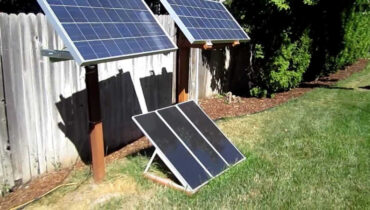How to backfeed a breaker panel with a generator? Whether you want to backfeed your apartment, house, or business, it is an illegal and dangerous practice in several jurisdictions. As long as you power your home using a manual transfer switch, it is safe.
Though I’m not an electrician, I was an EEC student. It is my field of interest. So, I will try to give you the best solution regarding this.
Table of Contents
What is a breaker panel?
A breaker panel is also known as a distribution board, electric panel, panelboard, DB box, or DB board. This electricity supply system component diverges the electrical power feed toward secondary circuits. At the same time, it provides a protective circuit breaker or fuse in the common enclosure for each circuit.
Usually, in a U.S.- styled board, breakers are arranged in two columns. Top to bottom, in each row, you can see breakers numbering from left to right. With many breaker panels manufacturers, this numbering system goes universal.
A different phrase- A, B, and C, fed each of the rows. This allows 2 or 3 pole common trip breakers. As a result, each phase gets one pole.
Commonly, in North America, permanently installed large equipment is wired line to line. This takes 2- pole or 3-slots in the panel giving 240 voltages for split-phase electric power and 3-phrase power 208 voltage.
Read More: What Can You Run On A 2000 Watt Generator?
What is back feeding an electrical panel with a generator
Electricity enters your house, being transformed from throttles power into 240 volts. Following certain routes through a breaker panel, it gets distributed to outlets, lighting, and appliances.
While doing backfeed, you’re powering your home up by allowing the reverse flow of power by connecting the generator to any appliance. Electricity is redistributed all around the house by moving the power backwards.
Generally, when people backfeed their houses, they use a DIY cord placed with 2-male plugs to connect with the generator. With this cord, electricity enters the main breaker via the branch circuit breaker of the outlet.
The main breaker panel, using the other branch breakers distributes the electrical power to the whole house. Additionally, this feeds out the power way of the main breaker to the transformer. This process results in thousands of voltages reversing, which aims to energize the utility lines of the neighbourhood.
Risks of backfeeding
When you electrify the utility lines in the way is illegal as well as threatening. So, how can you reduce the risk? By shutting the main breaker off, you can attenuate the hazard. However, this method gives no guarantee against electrocution risk in the home.
If the 240 volts backfeed cord comes out from the appliance outlet, anyone tripping or stumbling over it may face an electric shock. Exactly why sometimes this breaker panel backfeed cord is often known as suicide cord.
Moreover, while backfeeding; the service panel electrifies the whole circuit breaker panel distributing the power all-around your house. This level of power supply for the entire home is only available with a large portable generator. Even if you turn some breaker off, you cannot balance the loads.
Between 2-lines of 120 voltages, a generator is capable of supplying 240 volts. That means each line can deliver half of the capacity of the generator. If you connect all the essential circuits on the same line, the home will get only half the power of a portable generator. Moreover, the unbalanced electricity load will create pressure on the generator.
Read More: How many Watt Generator Do I Need To Run
The safest way
While during an outage, you’re hooking up with a generator; it is the most convenient and safest to connect it to the electrical service panel. And, for this, you have to wire it through an automatic or manual backfeed breaker or manual transfer switch along with an interlock.
According to the National Electric Code ((NNEC 700.5 and 701.5), you have to install a transfer switch to use a portable generator. This MTS panel helps to switch between the generator and the mains during a power failure. While the main breaker is closed for the panel, this interlocked backfeed breaker plays a role to prevent the generation connection.
Most of the standby generators come equipped with their own automatic MTS. But, with portable generators, this functionality isn’t available. So, you have to connect your transfer switch. With a properly installed transfer switch, you can electrify some of your household circuits with the generator from directly the service panel. So, no need to use the extension cords.
How to determine the MTS size
You have to determine the size of an MTS based on its capacity of maximum current in amps. Available sizes are starting from 30 amps to 3,000 amps. And if you pick the large one, it won’t be an issue, but money wastage.
So how to figure out what size transfer switch you need? You may have a chart of your home appliances that you need to use during an outage. Just add up the total numbers. And you would get the size of the amp. Also, you can take help from an electrician.
Installing a Transfer Switch
The best place to mount the transfer switch is on the wall beside the main service panel. While you’ll be wiring the MTS for particular breakers, each breaker would need 2-hot wires from the switch. Though the transfer switch comes with its cord, that is seldom long. So, you might have to replace it with a larger one.
Hence you have to hook up the power cable to the generator outside your house; an extension cord is what you need. To operate this switch-cord to an exterior wall, you have to connect the extension cord with the transfer switch through a power inlet box.
Installing the MTS to the panel is good to be done by a professional or homeowner with enough knowledge of electrical works. After de-energized the main breaker panel, you can connect the switch wires either to the selected particular breakers or the main breaker.
The following process is to install a box along with different switches. Each switch is for wiring up with an individual breaker. A 240- voltage operating circuit has double-pole breakers. There is only one set of wires equipped with each switch. So for controlling a 240-volt breaker, it requires 2-switches.
How Transfer Switch Works?
The transfer switch gets connected with the critical circuits like the water heater, furnace, range, refrigerator, interior lights, well pumps etc. It shuts off the utility line. At the same time, it opens the power line from the generator while the generator is running at speed.
Let’s see how to backfeed a breaker panel with a generator using an MTS–
Step 1
Connect the cord with the inlet box or transfer switch
Step 2
Turn off the transfer switch’s circuit breakers.
Step 3
Let the generator warm up after starting.
Step 4
Now, flip the transfer switches’ main breakers to the generator position.
If you’re using a diesel or gas generator, it’d be good if you periodically run it for a few minutes. This technique will help to circulate fuel all over the carburetor to keep it clean. Also, it will help to keep your generator in good condition and the internal parts to prevent seizing up.
Read More: What Size Generator For 30 Amp RV?
FAQs
If you don’t shut off the main breaker through the backfeeding generator process, power can backfeed to the outside utility line resulting in electrocuting a maintenance worker. Also, the imbalanced electrical loads can put inefficient and extra pressure on the generator.
Whenever you’re about to make any permanent addition to your home, you should collect the local authority’s permission. The same rule goes for generator transfer switches.
Your home wiring is no longer safe by a fuse or circuit breaker; while you plug in the generator directly into the wall outlet. As a result, there can be overheat, overload, and a fire startup in the house.
Whether added with automatic or manual functionality, a generator transfer switch costs approximately $200 to $400 by an electrician. It will take up to 4 hours to install.
The equalization formula to 1200 watts is watts = volts x amps. So you can have a 50 feet cord when your extension cord is 16 gauges. For the same equipment, for the 10-gauge cord, your maximum length would be 250 feet.
Final Thoughts
Generally, a power cut lasts a maximum of 24 hours. Using extension cords is a good option for a backfeed breaker panel with a generator. But, you would need to keep your window or door partially opened for the extension cords to pass thoroughly. It is not ideal while there is a storm, heavy wind or rainfall, or excessive cold. In that situation, how to backfield a breaker panel with a generator? A properly installed transfer switch is the best way regarding this. With only a single cord plugged into a power inlet box installed permanently, no need to keep your windows and doors opened.
Always remember that you should place your generator outside the house before starting up the process. Even if it is for regular maintenance, you should move it outside for safety precautions. So, are you just done with this follow-up on how to backfeed a breaker panel with a generator?

